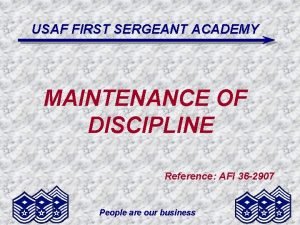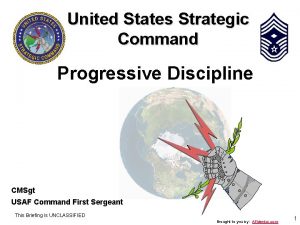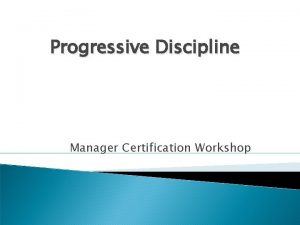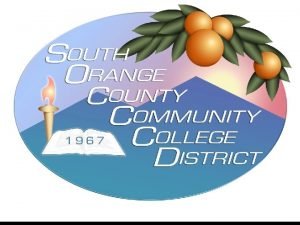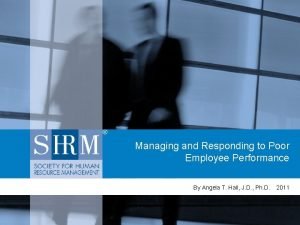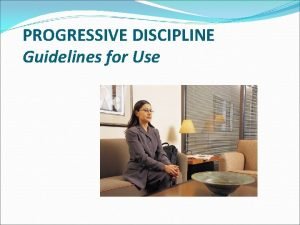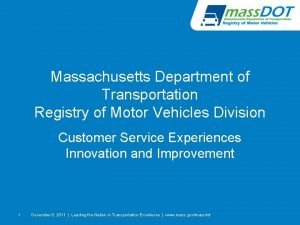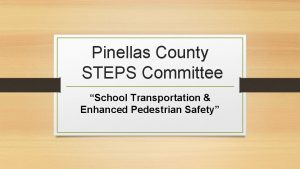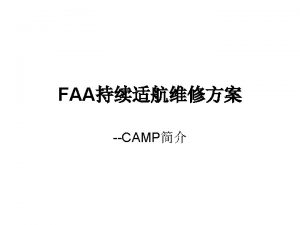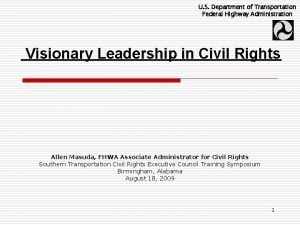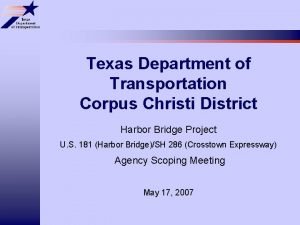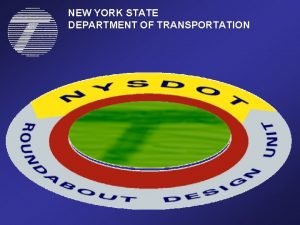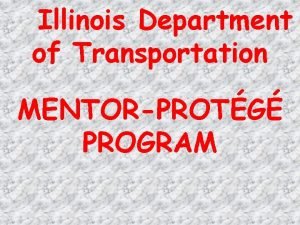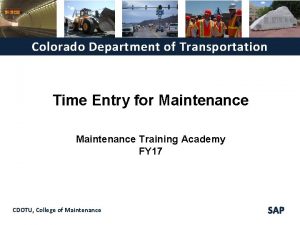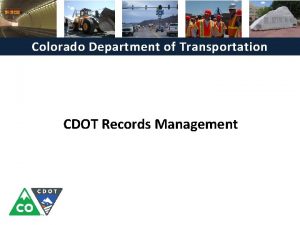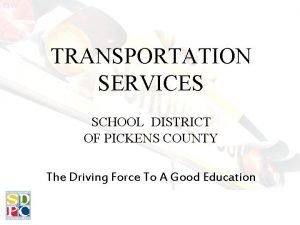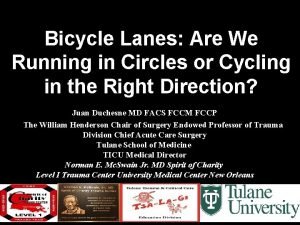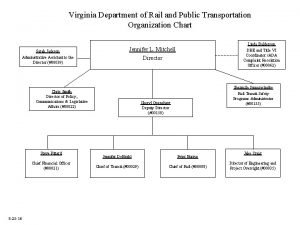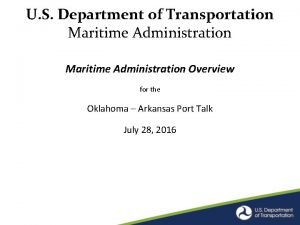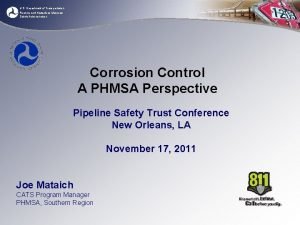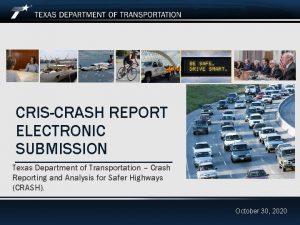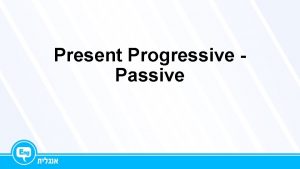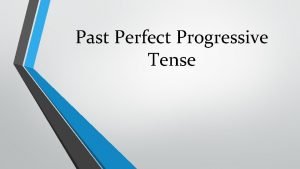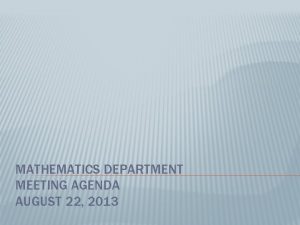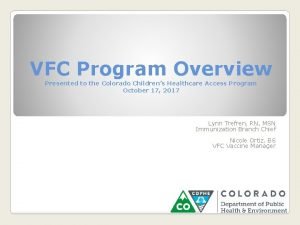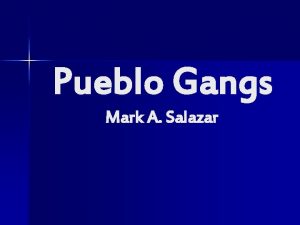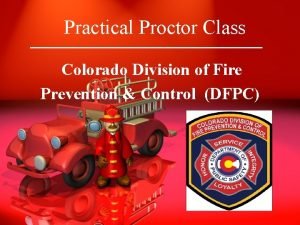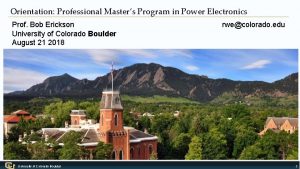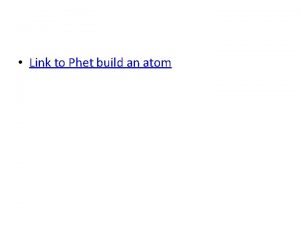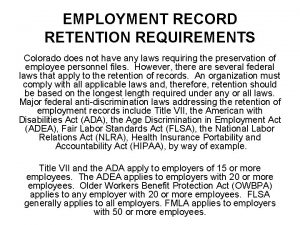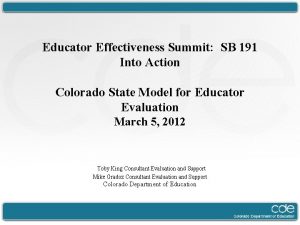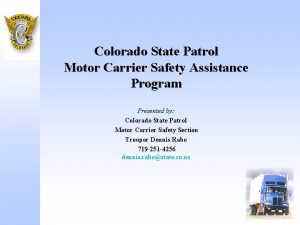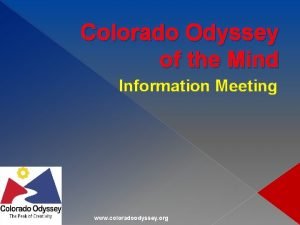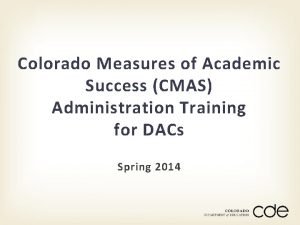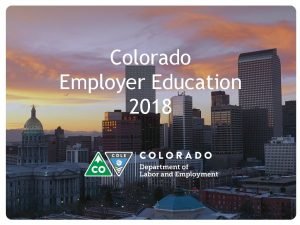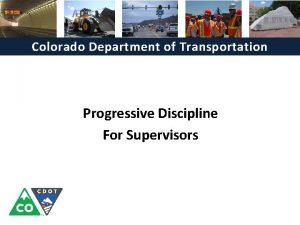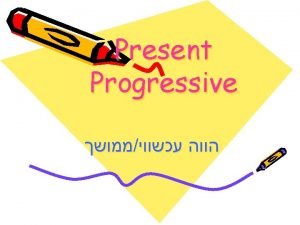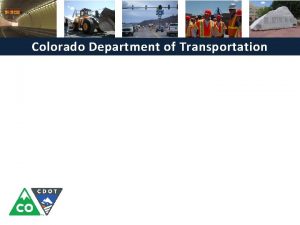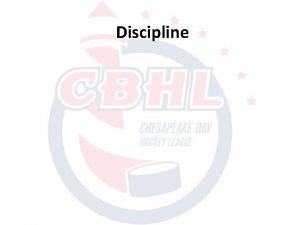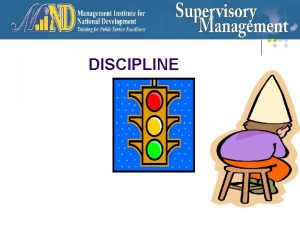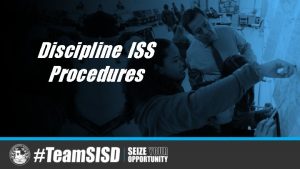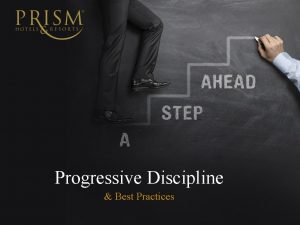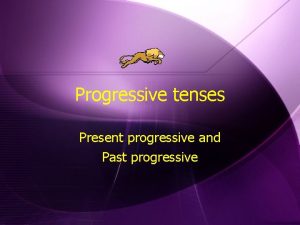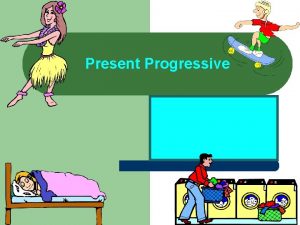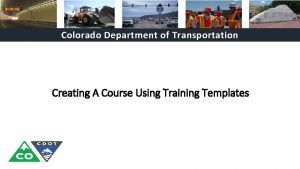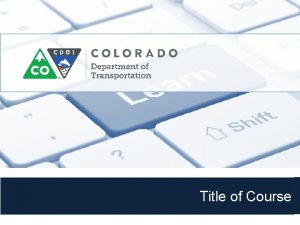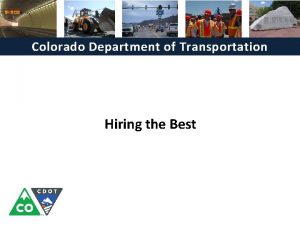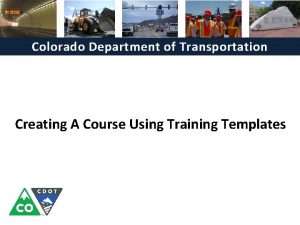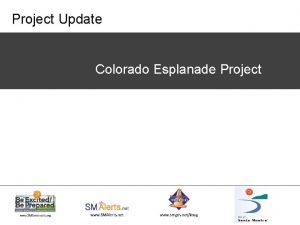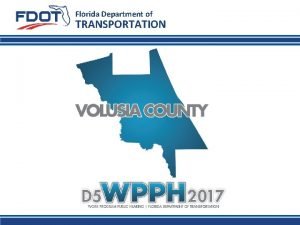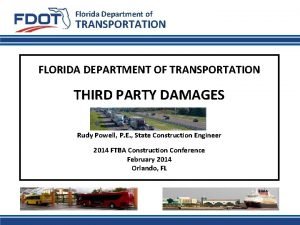Colorado Department of Transportation Progressive Discipline Course Agenda




















































- Slides: 52

Colorado Department of Transportation Progressive Discipline

Course Agenda • • • Learning Logistics Section 1 – Introduction to Progressive Discipline Section 2 – Counseling Employees Section 3 – Corrective Action Section 4 – Disciplinary Action Conclusion Colorado Department of Transportation Slide 4

Course Learning Objectives At the end of this course, you should be able to: • • • Describe the process of progressive discipline Identify how to resolve performance issues at the lowest possible level to improve employee performance Understand the connection be between Performance Management and Progressive Discipline Describe the levels (counseling, corrective action and disciplinary action and when they apply to the actions of the employee List resources available to the TMIII to help them with the progressive discipline process Colorado Department of Transportation Slide 5

Participant Introductions Please take a moment to share: • Your name • Your role within CDOT • Your expectations of this course Colorado Department of Transportation Slide 6

Learning Logistics • Classroom participation encouraged; ask, answer, and participate in the discussion • Exercise to practice development of training materials • Parking lot used to capture questions for in-class follow-up Colorado Department of Transportation Slide 7

Your Contributions to Learning • Please respect the other participants by silencing your cell phones • Focus on the course, please use the Internet and email over lunch and break times • Please delay your side conversations until break times • Attend the entire course to obtain credit for successful course completion Colorado Department of Transportation Slide 8

Did you know… The purpose of progressive discipline is to… • Resolve the performance issue at the lowest possible level • Help the employee by making them aware of their behavior and help them change it • Help others supervisors by documenting performance problems Colorado Department of Transportation Slide 9

Course Agenda • • • Learning Logistics Section 1 – Introduction to Progressive Discipline Section 2 – Counseling Employees Section 3 – Corrective Action Section 4 – Disciplinary Action Conclusion Colorado Department of Transportation Slide 11

Section 1 Learning Objectives At the end of this section, you should be able to: • • • Describe the purpose of Progressive Discipline Identify the roles in the Progressive Discipline process Identify the Progressive Discipline process at a high level Understand the connection between Performance Management and Progressive discipline Describe what actions do and do not fall under Progressive Discipline Essential Elements of each Progressive Discipline Colorado Department of Transportation Slide 12

Terms and Concepts • Progressive Discipline – Is the process of communicating what performance is for employee and using increasingly severe steps or measures when an employee fails to correct a issue with their performance. • Performance Management – The process by which CDOT involves its employees, as a group and individuals in improving the organization and accomplishing the goals and objectives • Investigate – The systematic steps towards seeking understanding of the facts of a performance issue. • Document – The process of recording the details of a performance event. Typically this includes the date of the event, who was involved, what occurred any reoccurrences Colorado Department of Transportation Slide 13

Purpose Progressive Discipline The purpose of progressive discipline is to: • Make the employee aware of their behavior and allow them the opportunity to change • Focus on the behavior that needs to change and not personality of the employee • Develop a business case by documenting the employees behavior prior to taking more additional action • Provide training/coaching to enforce rules and expectations • Communicate what is needed and not confront Colorado Department of Transportation Slide 14

Roles in the Progressive Discipline Process Employee Supervisor (TMIII) Appointing Authority 2 nd Level Manager The roles in the Progressive Discipline process are: • Employee • Supervisor (TMIII) • 2 nd Level Manager (LTC OPS) • Appointing Authority • Human Resources Labor Relations Colorado Department of Transportation Slide 15

Progressive Discipline Process • Establishes the Expectations of the Employee • AA meets with Employee 6 -10 applies, pay impacted • Supervisor Communicates the Expectations to the Employee 1. Performance Management 4. Disciplinary Action Colorado Department of Transportation 2. Counseling 3. Corrective Action • AA meets with employee, 6 -10 applies, pay is not impacted Slide 16

What Actions are not Covered Under Progressive Discipline The following are not part of the Progressive Discipline process: • Sexual Harassment • Workplace Violence Colorado Department of Transportation Slide 17

Connection Between Performance Management and Progressive Discipline Both Performance Management and Progressive Discipline: • Focused on the Performance of the employee • Require communication • Are specific to the needs of the employee • Evaluated Colorado Department of Transportation Slide 18

Elements of Progressive Discipline The element to successful Progressive Discipline are: • Informing the employee the of the need to change • Explaining what is acceptable behavior • Explaining the consequences of continued poor performance Informed Colorado Department of Transportation Explain Acceptable Explain Consequences Slide 19

Check Your Knowledge • What are the roles in the Progressive Discipline process? • Employee, Supervisor, 2 nd Level Manager, Appointing Authority and HR • What are the elements of successful Progressive Discipline? • Informed, Explain Acceptable and Consequences Colorado Department of Transportation Slide 20

Course Agenda • • • Learning Logistics Section 1 – Introduction to Progressive Discipline Section 2 – Counseling Employees Section 3 – Corrective Action Section 4 – Disciplinary Action Conclusion Colorado Department of Transportation Slide 22

Section 2 Learning Objectives At the end of this section, you should be able to: Describe the Performance Counseling Process Identify the two types of performance issues Identify the common signs of poor performance Describe the actions you need to consider and take to prepare for the session Identify actions you can take to be successful during the meeting Preparing for the meeting (set meeting, document examples of behavior, research potential solutions, keep private, policy website) • During the Session – (identify the issue, seek input from employee, identify a solution, clarify the issue, gain commitment, identify results of behavior (discipline) schedule follow up) • • • Colorado Department of Transportation Slide 23

Terms and Concepts • Employee Counseling – A meeting between the supervisor and the employee to discuss an issue with the performance or conduct of the employee with the attempt to resolve a performance issue • Performance – The way in which an employee works and interacts with to accomplish their job. • Performance Counseling Process - The process used when there is an issue with the employee’s performance that reaches the level that the supervisor needs to meet with the employee to resolve the issue with performance. • Conduct – the personal behavior of the employee during the performance of their work Colorado Department of Transportation Slide 24

Performance Counseling Process Prevention Follow-up Conducting the Session Colorado Department of Transportation Identification Preparation Slide 25

Performance Management and Prevention There are two types of Performance issues: 1. Performance – employee lacks a required knowledge, skill or ability to perform an aspect of their job or is unmotivated • Use Performance Goals to create awareness and support 2. Conduct – employee acts inappropriately or has attendance issues • Use counseling to create awareness Cure Prevention Colorado Department of Transportation Prevention Slide 26

Identifying the Signs of Poor Performance Signs of poor performance include: • Relying on others too much • Poor work quality • Violating Policy and/or Rules • Ignoring CDOT values • Missing deadlines • Not working well with other or affecting the others • High absentee rate • Employee is late or leaves early Identification Colorado Department of Transportation Slide 27

What to Consider When considering Performance and your employee: • Length of employment • Does the problem impact workflow or productivity • Are other employees impacted • Repetition and frequency • Mitigating circumstances Identification Colorado Department of Transportation Slide 28

Preparing for the Counseling Meeting Document Examples of Behaviors Research Potential Solutions Set the Meeting with the Employee Print out any documentation you want to provide to the employee Practice any difficult conversations Colorado Department of Transportation Preparation Slide 29

Step One – Documenting Behavior When documenting behavior in the Performance Log always include the: • Date and time of the event • Objectively describe the event using the employee’s name • Provide any details shared by the employee in the description • Outline the action you took • List any witnesses to the event Preparation Colorado Department of Transportation

Exercise One Scenario: • One of your employees, Ralph, who is usually quite conscientious (a 7 -year employee), was late for work twice week before last, late once last week, and it is Wednesday morning and this will be the second time this week. Ralph’s tardiness is usually 10 -15 minutes. All employees are aware of the seven-minute window for clocking in and clocking out. Sarah was working the front desk, and rolled her eyes as he went by. Action: • Document Ralphs behavior using the Performance Log Colorado Department of Transportation Slide 31

Step Two - Research Potential Solutions Now the problem has been identified, research solutions such as: • Counseling • Training / Partnering with an experienced employee • Verbal warnings • Explaining processes, policy or procedures • Agreed upon steps Preparation Colorado Department of Transportation Slide 32

When Creating a Solution… Keep in mind: • Similar actions for similar situations • Age, race, gender and protected classes should not be considered • This is a first step towards working with the employee Preparation Colorado Department of Transportation Slide 33

Exercise Two Scenario: • One of your employees, Ralph, who is usually quite conscientious (a 7 -year employee), was late for work twice week before last, late once last week, and it is Wednesday morning and this will be the second time this week. Ralph’s tardiness is usually 10 -15 minutes. All employees are aware of the seven-minute window for clocking in and clocking out. Sarah was working the front desk, and rolled her eyes as he went by. Action: Discuss possible solutions you would prepare for the meeting with Ralph Colorado Department of Transportation Slide 34

Sending the Request When sending the request: • Keep it friendly i. e. “Could you drop by later today? ” • Do not provide details • Do not call the person out in public • Wait until you are prepared Preparation Colorado Department of Transportation Slide 35

Documentation Examples of documentation include: • State Personnel Rules • CDOT Policy and Procedural Directives • Position Descriptions • Work aids and documents created by you and your team • Employee goals in Success. Factors Colorado Department of Transportation Slide 36

Preparing for Difficult Conversations To prepare for the conversation think about : • “Buttons” you might push • Identify buttons and plans to avoid them • Don’t assume • Ask questions instead on acting on assumptions • Check your attitude towards the conversation • • • Is there something in your actions that is going to cause the employee to react Be positive and solution oriented Reframe the “opponent” as a partner • Do not think of the employee as your opponent Colorado Department of Transportation Session Slide 37

Using Your W. I. T. S to Discuss Behavior When Communication the behavior: • Why – Provide context on how the behavior impacts others at CDOT • Immediate – Keep the feedback as close to the event as possible • Think Small - Think about the chain of events that leads to success or failure • Specific – Do not make your employees guess about behavior explain in detail what is needed Session Colorado Department of Transportation Slide 38

Exercise Three Scenario: • One of your employees, Ralph, who is usually quite conscientious (a 7 -year employee), was late for work twice week before last, late once last week, and it is Wednesday morning and this will be the second time this week. Ralph’s tardiness is usually 10 -15 minutes. All employees are aware of the seven-minute window for clocking in and clocking out. Sarah was working the front desk, and rolled her eyes as he went by. Action: Discuss possible solutions you would prepare for the meeting with Ralph Colorado Department of Transportation Slide 39

Follow up is important to express the actions both you and the employee need to take. The follow up should include: • The reason for the meeting • Why the behavior is not acceptable • Any concerns addressed by the employee • The process you and the employee have agreed to improve the employee’s performance • Any actions you need to take Follow-up Colorado Department of Transportation Slide 40

Check Your Knowledge • What are the five stages of the Performance Counseling Process? • Prevention, Identification, preparation, conducting the session and follow up • What should you not consider when creating a solution? • Age, race or protected class information Colorado Department of Transportation Slide 41

Course Agenda • • • Learning Logistics Section 1 – Introduction to Progressive Discipline Section 2 – Counseling Employees Section 3 – Corrective Action Section 4 – Disciplinary Action Conclusion Colorado Department of Transportation Slide 43

Section 3 Learning Objectives At the end of this section, you should be able to: Explain when counseling needs to move onto corrective action Differentiate between a corrective action and a disciplinary action Describe what a corrective action is and why it is created Identify the roles involved in the corrective actions process (employee, TMIII, second level manager, employee relations, civil rights manager) • Elements of the corrective action plan (background, expectations timeframe, consequences if not met, statements rights and grievance • When to fill in a PIP or use the corrective action plan • • Colorado Department of Transportation Slide 44

Terms and Concepts • Corrective Action – • Corrective Action Plan – Colorado Department of Transportation Slide 45

Exercise XX Roles: Scenario: Colorado Department of Transportation Slide 46

Check Your Knowledge Colorado Department of Transportation Slide 47

Course Agenda • • • Learning Logistics Section 1 – Introduction to Progressive Discipline Section 2 – Counseling Employees Section 3 – Corrective Action Section 4 – Disciplinary Action Conclusion Colorado Department of Transportation Slide 49

Section 4 Learning Objectives At the end of this section, you should be able to: Colorado Department of Transportation Slide 50

Terms and Concepts • Disciplinary Action – • Disciplinary Action Letter – • 6 -10 Meeting – Colorado Department of Transportation Slide 51

Exercise XX Roles: Scenario: Colorado Department of Transportation Slide 52

Check Your Knowledge Colorado Department of Transportation Slide 53

Course Agenda • • • Learning Logistics Section 1 – Introduction to Progressive Discipline Section 2 – Counseling Employees Section 3 – Corrective Action Section 4 – Disciplinary Action Conclusion Colorado Department of Transportation Slide 55

Conclusion You should now be able to: • • • Describe the process of progressive discipline Identify how to resolve performance issues at the lowest possible level to improve employee performance Understand the connection be between Performance Management and Progressive Discipline Describe the levels (counseling, corrective action and disciplinary action and when they apply to the actions of the employee List resources available to the TMIII to help them with the progressive discipline process Colorado Department of Transportation Slide 56

Where Can I Get Help – People? For additional assistance contact: Region Name Email Phone One Kathy M. Williams kathy. williams@state. co. us 303 -757 -9386 Two Mary Vigil mary. vigil@state. co. us 719 -546 -5432 Three Chip Brazelton chip. brazelton@state. co. us 970 -683 -6210 Four Juliet Sheets juliet. sheets@state. co. us 970 -350 -2156 Five Jason Benally jason. benally@state. co. us 970 -385 -1403

Other CDOT Help Resources The following resources are available: • Access information about Corrective and disciplinary actions at: • http: //intranet. dot. state. co. us/employees/performancemanagement/corrective-disciplinary-actions • Sample letters for corrective or disciplinary actions: • http: //intranet. dot. state. co. us/employees/performancemanagement/sample-letters • List of Appointing Authorities: • http: //intranet. dot. state. co. us/employees/appt-authority Colorado Department of Transportation Slide 58

Questions? Colorado Department of Transportation Slide 59
 Maintenance discipline
Maintenance discipline Usaf progressive discipline
Usaf progressive discipline Air force progressive discipline chart
Air force progressive discipline chart Frisk documentation model
Frisk documentation model Pip template shrm
Pip template shrm Identify the progressive discipline system of ems
Identify the progressive discipline system of ems What is progressive discipline
What is progressive discipline Agenda sistemica y agenda institucional
Agenda sistemica y agenda institucional Massachusetts department of motor vehicles
Massachusetts department of motor vehicles Montana department of transportation
Montana department of transportation Pcsb transportation
Pcsb transportation Department of transportation
Department of transportation Department of transportation
Department of transportation Maricopa county department of transportation
Maricopa county department of transportation Texas department of transportation corpus christi
Texas department of transportation corpus christi New york state department of transportation
New york state department of transportation Department of transportation
Department of transportation 417 toll rates
417 toll rates Department of transportation
Department of transportation Department of transportation
Department of transportation Pickens county bus transportation
Pickens county bus transportation Department of transportation
Department of transportation Virginia department of rail and public transportation
Virginia department of rail and public transportation Us department of transportation maritime administration
Us department of transportation maritime administration Department of transportation
Department of transportation Criscrash
Criscrash Past progressive agenda web
Past progressive agenda web Present progressive passive examples
Present progressive passive examples Past simple past progressive present perfect
Past simple past progressive present perfect Past perfect progressive objasnjenje
Past perfect progressive objasnjenje Math department meeting agenda
Math department meeting agenda Soldier course vs sailor course
Soldier course vs sailor course Course number and title
Course number and title Course interne moyenne externe
Course interne moyenne externe Microsoft dynamics gp colorado
Microsoft dynamics gp colorado Colorado vfc
Colorado vfc Https://phet.colorado.edu
Https://phet.colorado.edu Resilience
Resilience Pueblo gangs
Pueblo gangs Dfpc jprs
Dfpc jprs Ecen 5797
Ecen 5797 L oiseau du colorado poesie
L oiseau du colorado poesie Phet build an atom
Phet build an atom School readiness report template
School readiness report template Payroll retention rules in co
Payroll retention rules in co Colorado principal quality standards
Colorado principal quality standards Devre yapım kiti sanal laboratuvar
Devre yapım kiti sanal laboratuvar Colorado state patrol motor carrier safety
Colorado state patrol motor carrier safety Fire mitigation colorado springs
Fire mitigation colorado springs Colorado springs school districts
Colorado springs school districts Colorado odyssey of the mind
Colorado odyssey of the mind Colorado measures of academic success
Colorado measures of academic success Www.coloradoui.gov.myuiemployer
Www.coloradoui.gov.myuiemployer
